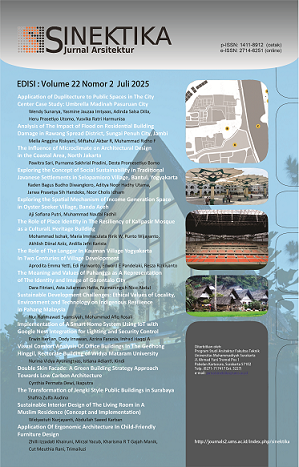Application of Ergonomic Architecture in Child-Friendly Furniture Design
DOI:
https://doi.org/10.23917/sinektika.v22i2.6924Keywords:
Child-Friendly, Ergonomic Architecture, Furniture Design, Growth And Development, Physical AbilityAbstract
The state's commitment to ensure child protection in the Constitution No. 16 of 2016 concerning child protection, states that every child has the right to survival, growth, and development as well as the blessing of protection from violence and discrimination. Research conducted by Susenas and Riskesdas (2018), based on data from the National Socio-Economic Survey Integration, the analysis of the Early childhood development Index (ECDI) is known whether an early childhood has developed well according to its stages and age. These developments not only aim to ensure good literacy, numeracy, physical, social-emotional, and learning skills, but also pay attention to the fulfillment of health, nutrition, and care and nurturing aspects. However, it is different from the conditions in North Sumatra, based on data from BPS Medan City, where children aged 36-59 months have not developed physical abilities according to their stages. Therefore, this study was conducted to examine the application of ergonomic architecture in child-friendly furniture design as a form of needs to support children's learning and play activities. The method used is in the form of qualitative descriptive with a design thingking method approach and the application of ergonomic architecture in a child-friendly furniture design, data collected at a PAUD in Medan City to children with an age range of 0-6 years through observation and interviews. The results of this study show that child development through sensory can be optimized with furniture design that suits children's needs, the concept of child-friendly furniture design as a reference and an alternative approach to early childhood development with the application of ergonomic architecture in optimizing growth and development as well as a guide in educating children according to the growth period.
Downloads
References
Amalina, S., Wahid, F., Satriadi, V., Farhani, F. S., & Setiani, N. (2017). Design a UniBook Application Prototype Using the Design Thinking Approach. Semin Nas Apl Teknol Inf, 50–55.
Ardelia, M., Santosa, A., & Setiati, G. (2019) Design of Storage Facilities and Creativity Learning for Early Childhood. J Intra, 7(20), 802–808.
Aura, I., Hassan, L., & Hamari, J. (2021). Teaching within a Story: Understanding storification of pedagogy. Int J Educ Res, 106. 101728.
Central Bureau of Statistics. (2018). Analysis of Early Childhood Development in Indonesia 2018 – Integration of Susenas and Riskesdas 2018.
Central Bureau of Statistics. (2020). The central bureau of statistics in the city of Medan 2020.
Claudia, L., & Grace Mulyono, L. B. (2017). Furniture Set Design As Facilities. 5, 759–768.
Cobb, E. (1993). The ecology of imagination in childhood. 88(xv), 139.
Driediger, M., Vanderloo, L. M., Truelove, S., Bruijns, B. A., & Tucker, P. (2018). Encouraging kids to hop, skip, and jump: Emphasizing the need for higher-intensity physical activity in childcare. J Sport Heal Sci, 7, 333–336.
Fittryati, S. A., Arsitektur, J. T., Sains, F., Teknologi, D. A. N., Islam, U., Maulana, N., & Ibrahim, M. (2020). Sidoarjo With a Child Friendly Architectural Approach according to Permendikbud No 137 of 2014 Sidoarjo With a Child Friendly Architectural Approach according to Permendikbud No 137 of 2014.
Gaziulusoy, A. İ. (2020). The experiences of parents raising children in times of climate change: Towards a caring research agenda. Curr Res Environ Sustain, 2, 100017.
Hasimjaya, J. (2017). Anthropometry & Ergonomic Study of Furniture Design for 3-4 Years Early Childhood Education in Siwalankerto. Intra, 5, 449–459.
Irawati, S. I., Sumaryoto, & Hardiyati. (2020). Application of architectural psychology. Senthong, 3, 188–199.
Lai, S. L., & Shu, L. H. (2014). Do-it-yourselfers as lead users for environmentally conscious behavior. Procedia CIRP, 15, 431–436.
Mastuinda, M., & Suryana, D. (2014). Aggressive behavior early childhood. J Ris Golden Age PAUD UHO, 8, 269–280.
Milojković, A., Tamburić, J., Stanković, D., & Brzaković, M. (2019). Influence of space on interactivity aspects in pre-school facilities in the city of niš, Serbia: Case study analysis. The Vjesn, 26, 793–800.
Nurulhuda, D., Nirawati Maya, A., & Ummul, M. (2019) Child-friendly architectural design. 2, 121–132.
Pemerintah Indonesia. (2016). Undang-Undang Nomor 16 Tahun 2016 tentang Pengesahan Paris Agreement To The United Nations Framework Convention On Climate Change. Tambahan Lembaran Negara Republik Indonesia Nomor 5939. Sekretariat Negara. Jakarta.
Pemerintah Indonesia. (2017). Undang-Undang Nomor 17 Tahun 2016 tentang Penetapan Peraturan Pemerintah Pengganti Undang-Undang Nomor 1 Tahun 2016 Tentang Perubahan Kedua Atas Undang-Undang Nomor 23 Tahun 2002 Tentang Perlindungan Anak Menjadi Undang-Undang. Tambahan Lemaran Negara Republik Indonesia Nomor 5882. Sekretariat Negara. Jakarta.
Platokhina, N. A., Samarina, I. V., Abashina, N. N. (2016). Preventive Measures against Speech Disorders in Early Childhood. Procedia - Soc Behav Sci, 233, 247–251.
Putrihapsari, R., Fauziah, P. Y. (2020). Early Childhood Care Management in Working Mothers: A Literature Study. JIV-Jurnal Ilm Visi, 15, 127–136.
Radha, R. K. (2021). Flexible smart home design: Case study to design future smart home prototypes. Ain Shams Eng J. https://doi.org/10.1016/j.asej.2021.05.027
Rahadiyanti, M., Wardhani, D. K., Rambung, E., & Silitonga, H. T. H. (2021). Redesigning space-friendly a child at daycare griya children Surabaya. Kacanegara J Devotion to the community, 4, 29.
Rathod, A. (2021). The Intersection of ‘Outside’ Practices and Children’s Sedentary Behavior at Home. Home Cult, 0, 1–21.
Rimadiana, S. F. (2016). Modular Furniture Set Design For Children's Room Ages 2-5 Years With A Montessori Approach. Rev Bras Geogr Física, 11, 141–156.
Said, Ismail. (2017). Architecture for Children: Understanding Children Perception towards Built Environment. 1–11.
Stevenson, O., Prout, A. (2013). Space for play? Families’ strategies for organizing domestic space in homes with young children. Home Cult, 10,135–158.
Szymanski, M. (2002). Marketing toys by developmental stages. Young Consu, 3, 25–32.
Tjahjono, V. G. (2017). Evaluation of PAUD Furniture Design in Siwalankerto, Surabaya. Intra, 5, 531–540.
Downloads
Submitted
Accepted
Published
Issue
Section
License
Copyright (c) 2025 Sinektika: Jurnal Arsitektur

This work is licensed under a Creative Commons Attribution-NonCommercial 4.0 International License.











